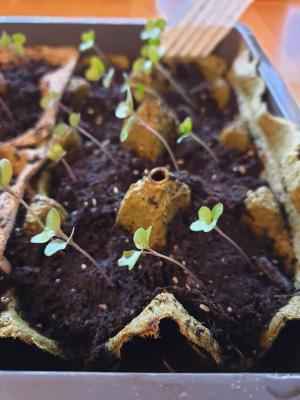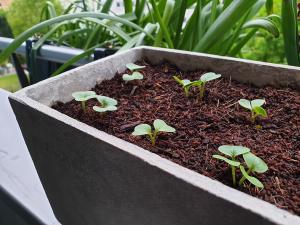The Scary Seed
This is the year, the year that I’m finally going to face a fear. In the past I’ve avoided it and paid the price. It’s the seed.

Tithonia seedlings I forgot to water; luckily they sprung back after a good soak.
That’s right, I’ve been afraid of starting from seed. Who wants to get their hopes up watching their tiny seedlings grow, only to see them die later?
And I don’t think I’m the only one. But it’s important to learn how to grow from seed—for the sake of our wallets. So this year I’m going full force, it’s all or nothing; I’ve set up not one, not two, but three seed stations.

Dramatics aside, starting from seed seems relatively easy as long as a few factors are followed. Today will be a quick explanation so that you can get started. Detailed reviews of the seed station setups will be provided in the future along with expanded explanations.
“Soil” Mediums
When starting seeds indoors, it’s best to use mixes specifically for seeds. Qualities of seed-starter mix include sterility, uniformity, lightness in weight, and low in nutrients. Giving your seedlings a clean, disease-free medium allows for the best chance of survival during their critical first few weeks. Exceptions are hungrier plants such as corn, squash and beans, which require a general purpose, nutrient-rich mix while in pots to satisfy their appetite.

Moisture
It’s important to keep the medium moist to begin the process of germination. Once the seed breaks dormancy, water is used to fill and expand the cell vacuoles within plant cells and transport soluble nutrients into the plant. It’s very important to keep seedlings moist since they are not yet large enough to store excess water in roots and leaves for periods of drought simply because they do not have many roots or leaves yet.

Temperature
Temperature tells the seed what season it is so they don’t sprout during the wrong time of the year and perish. This varies from seed to seed but in general seeds like a temperature between 18-22C (64-72F). Read the seed packet to find out if your seeds require a different temperature range.
Light
Seedlings require a lot of light. They continue to grow towards light until they reach sufficient light levels. When they don’t have enough light, they think they are still in the soil or being shaded out by plants. They’ll keep stretching until their energy reserve is exhausted, leaving little strength to properly thicken the stem and develop a stable set of roots and true leaves.
Sunny windows are typically not enough. The light comes from one direction and once the light hits the glass it refracts, resulting in lower intensity. During the early and late portions of the year in the northern hemisphere, the sun’s rays are relatively weak due to the angle of the earth in relation to the sun. The combination of the early-year low sun angle and one-directional window refraction of light creates a low-light situation that’s not ideal for proper plant growth.

It is possible to grow seeds next to the window in mid to late spring but you’ll have to remember to turn them a few times each day to mitigate leaning, and they won’t be as sturdy as seedlings grown under the sun or lights since they have a tendency to stretch.
Having a greenhouse or cold frame helps solve the one-directional light issue since the sun moves over the sky but the seedlings will still be slow to grow due to the early-year low light intensity and the short day length.
Using grow lights and some bright shop lights solve this indoor issue.
In conjunction with light intensity, is the length of time the light needs to be on. Seedlings require a minimum of 12-15 hours of light per day. That makes sense since daylight length in April, the average time when seeds and plants outdoors begin sprouting, reaches 12-13 hours. It’s important to note that they also require a dark period of rest so don’t think you can leave grow lights on 24⁄7 in hopes of growing a massive plant quicker.

Air Circulation
The last important factor is air circulation. This prevents a fungal disease called damping off. Fungi thrive in a moist low-airflow environment. And while fungi are important in plant health, the strains that cause damping off are not. The easiest prevention is placing seedlings in an area with good air circulation, using a fan if needed, as well as using a sterile seedling potting mix.
Sowing Seeds
Once you have your sterile potting mix, pots, and seeds it’s time to start sowing. Today’s focus will be on foxglove, radishes and tomatoes as they are some of the ones I’ve had the most success with so far.
For foxglove and tomatoes I recommend using small seed plug trays or small containers. The benefit is that it uses less medium during their germination stage and allows them to create a nice plug of roots; enough to hold the medium together but not enough to become root bound (roots wrapping around within the container). Using less medium is also more cost effective. Seedling potting mix is not the cheapest, so if some seeds do not germinate, little medium was wasted. It also does not have many nutrients, so by the time the seeds grow their first set of true leaves, the roots will have taken up the space within the plugs and be ready for transplant in a more nutrient rich mix.
Fill your containers with medium and then gently tap the containers on a table to settle it. Do not press on the medium! This compacts it, making it difficult for seedling roots to push through and providing less micro spaces for air and water pockets, both of which plant roots need.

Tiny foxglove seeds
Next, it’s very important to read the seed packet or look up online at what depth to sow the seeds. Foxglove seeds need light to germinate so they are sown directly on top of the medium. Tomatoes require a planting depth of a ½ cm (¼ in) of medium. If seeds are sown too deeply they risk rotting from the damping-off fungi; too shallow and they stay dry and will not germinate. A general rule is sow seeds a depth of their size. Foxglove seeds are tiny, like dust, sprinkle them as thinly as possible over the surface. Tomato seeds are larger, place two seeds per cell on top of the medium, then poke them in using a pencil tip to a depth equal to the diameter of the seed; cover lightly with soil.

Soaking the seed tray
After sowing the seeds, soak them. It’s best to water from below and allow the water to soak up. This prevents a gush of water from washing away the mix and seeds. Fill a flat container with room temperature water and place seed trays or seed pots inside. Leave in the pool of water until the surface of the medium is moist. This will take at least 15 minutes. Alternatively you could use a fine mist spray bottle or hose with a fine mist attachment but this could take longer to fully saturate the mix.
Radishes are slightly different, they require being directly sown in their permanent place until harvest, which is true for most root crops. Sow directly in the garden or use a container with at least 15 cm (6 in) depth.
Fill the container with a nutrient rich potting mix, not seed-starter mix! Remember, they will be here permanently for the next month and require nutrients to grow. I recommend watering the mix at this point since it’s a larger/deeper pot that can be more difficult to saturate from soaking; that is, if you don’t have a container larger and deeper than what you plan on using. Create small impressions in the soil using the back of the pencil 1 cm (½ in) deep spaced 2.5 cm (1in) apart. Cover lightly with soil and mist the top to prevent disturbing the seeds.



Radishes are a cool weather crop and can be placed outside or sown directly as soon as the soil is workable. The foxglove and tomato seeds should be placed in your designated seed station.
Once the true leaves of the tomatoes and foxgloves are large enough to start crowding out neighboring seedlings, generally larger than the cotyledons (seed leaves), transplant them into a slightly larger pot with nutrient-rich mix. The goal is to form a nice plug of roots and keep the seedlings continually growing. You may pot on as many as 3-4 times before the plants are ready for the garden.
I suggest these three seeds because they are pretty forgiving. Radishes basically take care of themselves during the 25-30 days until harvest: tomatoes will easily show you when they are unhappy and bounce back quickly: and foxgloves will pause their growth until conditions are favorable again. So if you’re new to seeds, I recommend giving these three a try.



- Filed to:
- Seeds


